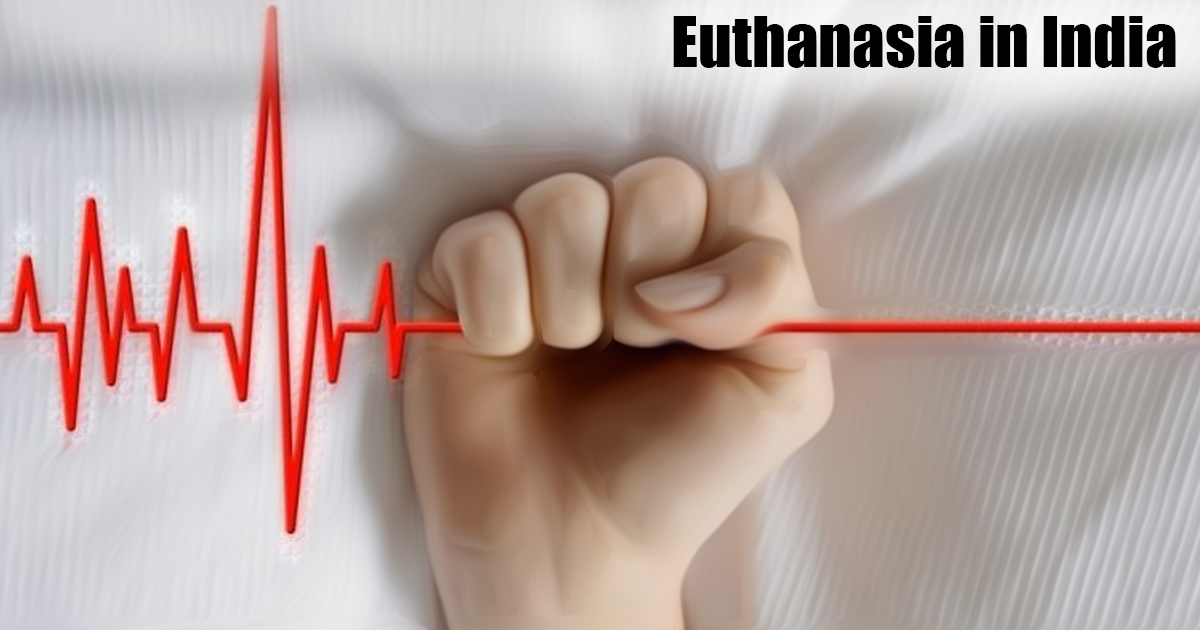
Context:
Recently, the Supreme Court of India declined a request to remove a Ryles tube from a patient in a vegetative state, even though the 2018 judgment on passive euthanasia permits the withdrawal of life support in terminal cases.
Understanding Euthanasia:
Euthanasia, also known as mercy killing, refers to intentionally ending a person’s life to relieve them from suffering, typically in cases of severe, incurable, and terminal conditions.
Legal Framework Surrounding Euthanasia in India
- 2018 Supreme Court Ruling:
In 2018, the Supreme Court of India legalized passive euthanasia, which involves withdrawing life support for terminally ill patients, provided there is a ‘living will.’- A living will is a formal document in which an individual specifies their preferences for medical treatment in situations where they can no longer express informed consent. This document must be signed in the presence of two witnesses and countersigned by a Judicial Magistrate of First Class (JMFC).
- The Aruna Shanbaug Case (2011):
This landmark case allowed passive euthanasia under certain conditions. Aruna Shanbaug, a nurse who remained in a persistent vegetative state for several decades following a brutal assault, became central to this ruling. The Supreme Court made a clear distinction between active euthanasia (which involves direct actions to end life) and passive euthanasia (which involves withholding or withdrawing medical treatment), sanctioning the latter under specific circumstances. - Law Commission Reports:
- 196th Report (2006): Emphasized that adhering to a patient’s wishes to withhold or withdraw medical treatment is neither a violation of professional duty nor an offense.
- 241st Report (2008): Suggested legislation for passive euthanasia and drafted a bill highlighting the necessity of a structured legal framework.
- The Harish Rana Case (2024):
The Supreme Court refused to permit the removal of a Ryles tube from a patient in a vegetative state, ruling that it does not qualify as a life support system.
Recent Simplifications in Euthanasia Law
- Medical Board Formation:
Now, hospitals directly form the medical boards required to evaluate passive euthanasia cases, ensuring a more streamlined process. This change eliminates delays caused by involving multiple authorities. - Experience Requirements Reduced:
The required years of experience for doctors on these boards have been decreased from 20 to 5 years. - Simplified Procedure:
Approval from a magistrate is no longer needed; simple notification suffices. A signature from witnesses and a notary or a gazetted officer can replace the countersignature of a magistrate.
Arguments in Favor of Euthanasia
- Dignity in Death:
Allows patients to avoid unbearable pain and suffering, as seen in countries like the Netherlands, where euthanasia is an option for terminally ill patients. - Avoidance of Prolonged Medical Treatments:
Prevents patients from undergoing unnecessary medical interventions that offer no hope of recovery. - Potential for Organ Donation:
Euthanasia could enable patients to choose to donate their organs, as practiced in Belgium. - Financial Relief:
Eases the financial burden on families by avoiding prolonged and expensive treatments. - Right to Die with Dignity:
Recognized judicially as part of the right to life under Article 21, as highlighted in the Aruna Shanbaug case.
Arguments Against Euthanasia
- Moral and Religious Opposition:
Many religions, including Christianity and Islam, oppose euthanasia, viewing life as a divine gift that only God can take away. - Risk of Abuse:
Concerns exist about the potential for non-voluntary euthanasia or unclear consent. - Slippery Slope:
Fears that acceptance of euthanasia might expand to include less severe conditions over time. - Conflict with Medical Ethics:
The World Medical Association opposes euthanasia, arguing it contradicts the fundamental principles of medical practice.
Recommendations for Moving Forward
- Strict Legal Regulations:
Enforce rigorous guidelines to regulate passive euthanasia and prevent misuse, similar to the strict protocols followed in the Netherlands, requiring consultations with multiple doctors. - Public Awareness Campaigns:
Promote understanding of the ethical and legal aspects of euthanasia and educate on end-of-life care options like Advance Care Planning and Advance Medical Directives. - Robust Judicial Oversight:
Ensure comprehensive judicial review for euthanasia cases, considering ethical, legal, and medical perspectives. India’s current process requires a multi-tier review involving a medical board and High Court judges. - Focus on Palliative Care:
Enhance palliative care options as an alternative to euthanasia. For example, Kerala’s palliative care program aims to improve the quality of life for terminally ill patients, thereby potentially reducing the demand for euthanasia.




